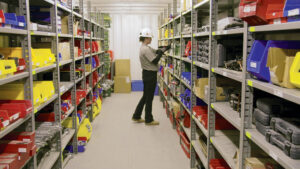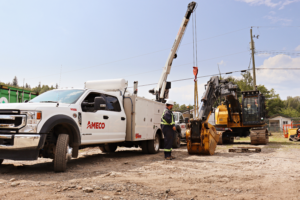How integrating Site Services improves construction outcomes
The United States has entered a new era of domestic production. A lot of news coverage has focused on the “reshoring” of American manufacturing and the boom in next generation vehicles. The entire American industrial sector is set to see incredible growth over the next five years. And that growth is set to unleash unprecedented demand for the construction industry.
As one sector grows, so does another
For example, electric vehicle (EV) manufacturing is having its day. Plants are being built across North America with factories going up in Texas, Michigan, Missouri, Ohio, Georgia, Tennessee, and Indiana. The surge in EV manufacturing spawns growth in other industries as well.
In addition to building the vehicles, there is huge capacity for EV batteries. Battery plants are going up in Nevada, Kentucky, Georgia, Tennessee, Michigan, and elsewhere. EV batteries need the raw materials, leading to a boom in mining and metal recycling with associated projects planned or being built in the Carolinas, Nevada, and Arizona.
The power grid needs to be prepared for the increasing number of electric vehicles, thus the billions of dollars in new power capacity being added to the grid across North America. A significant amount of that planned power capacity is solar .According to the US Energy Information Administration, solar will make up almost 60 percent of new electric generating capacity in the US this year. Thanks to incentives to use domestically created solar panels and components, there are several solar panel manufacturing plants going up in Ohio, Maryland, Louisiana, and Missouri.
… you get the picture. The point is that it is an exciting time for American industry, and a very exciting time to be in American industrial construction.
The challenges of so much construction
Executing any one of these projects of this magnitude comes with great challenges and constraints. How do owners or contractors attain workforce large enough to support the project? Considering some lingering supply chain challenges and sometimes quite remote jobsites, how can construction managers ensure the right tools and equipment are in place when they’re needed by craft workers?
These challenges can be mitigated with partnerships, a willingness to integrate new techniques for adding efficiency, and planning. A lot of planning.
An Integrated Site Services Approach to Construction
Planning is essential for constructing a modern megaproject. That is obvious on its face. With a total installed cost landing in the hundreds of millions or even billions of dollars, complex process equipment, intricate piping design, sensitive instrumentation, and rigorous timelines, there is no way these projects would be successful without hours of painstaking planning and collaboration.
To improve results in almost every aspect of construction, and especially safety, budget, subcontractor productivity, and schedule, planners should invest as much care and detailed planning in providing construction indirect services as they do in direct construction activities. Below are four examples of indirect construction services that will make the biggest impact on safety, schedule, and total installed cost when integrated into planning during detailed engineering.
Integrated Scaffold Solution
Scaffolding exemplifies how an integrated approach can significantly impact key factors like safety, cost, and schedule. The earlier scaffold planning can be brought into the process, the greater the impact will be. When scaffold designe rs are involved early, they spot potential conflicts and either eliminate them or prepare ahead of time for modifications that will be needed. This has a dramatic impact on both labor hours and overall cost by eliminating unnecessary rework.
rs are involved early, they spot potential conflicts and either eliminate them or prepare ahead of time for modifications that will be needed. This has a dramatic impact on both labor hours and overall cost by eliminating unnecessary rework.
For example, a recent AMECO scaffold analysis comparing an integrated approach versus a conventional approach on a major liquefied natural gas (LNG) project found that while planning and initial erection hours were higher in the integrated approach, modifications were eliminated. This resulted in a decrease of more than 2,000 hours, which led to almost $160,000 in modification cost savings. Total design hours were reduced by 35 percent. In total, the integrated approach led to overall savings of 60 percent compared to the traditional approach.
With so many projects and a tight labor market, it can be challenging to find enough labor in the construction industry today. That makes efficient scaffold labor a critical component of project execution. Ensure that your scaffold provider understands the labor needs for the type of scaffolding material that is being used. For example, ringlock scaffolding material typically requires crews of four to six laborers, while other scaffold systems, such as PERI Up can be erected by teams of two or three. Meanwhile, different scaffolding systems have varying requirements for tools (which can increase drop hazards), decking (which can contribute to trip hazards) and consumables, such as tie wire and lumber (which is time consuming to install, increases cleanup and disposal costs, and counters site environmental/sustainability efforts). Understanding these scaffolding requirements and impacts allows project management teams to see the big picture when developing site access plans.
VIDEO: See the difference between PERI Up and ringlock and cuplock scaffolding
A sitewide tool solution
 On large complex projects, there is a need for a lot of tools and a steady supply of consumables. Tool costs can quickly escalate without foresight. Subcontractors often say they prefer to provide their own tools. What’s not often said is that tool provision can be where subcontractors build in their margin. Besides that, allowing various subs to bring in different brands of tools opens the risk of variations in tool calibration and an excessive number of tool cribs stocked with redundant, but incompatible consumables.
On large complex projects, there is a need for a lot of tools and a steady supply of consumables. Tool costs can quickly escalate without foresight. Subcontractors often say they prefer to provide their own tools. What’s not often said is that tool provision can be where subcontractors build in their margin. Besides that, allowing various subs to bring in different brands of tools opens the risk of variations in tool calibration and an excessive number of tool cribs stocked with redundant, but incompatible consumables.
Working with an integrated partner to provide tools sitewide dramatically affects overall tool cost over the project’s lifecycle. Through careful analysis of work packages, a robust planner can understand what tools and consumables are needed when based on the craft curve. And because they are procuring tools for an entire site of thousands of laborers, they can obtain favorable tool rates while also getting white glove treatment from the tool providers who are eager to ensure orders are delivered without interruption.
Since the integrated partner has a bird’s eye view of all tool usage, processes for tool inspection, maintenance, and repair can be implemented for enhanced safety and increased time on tools, and tool loss can be monitored and kept in check starting from day one.
Hydration for the entire site
 Proper workforce hydration is critical to working safely, especially in the summer months. It seems like a simple fix – put coolers out around the site with some bagged ice and bottled water and call it a hydration program. That’s actually a very inefficient – and labor intensive – way to handle workforce hydration. Despite proper hydration being important to health, safety, and environmental (HSE) goals onsite, it’s often treated as an afterthought. Many construction managers’ hydration plan includes picking up a case or two of water on the way in each day.
Proper workforce hydration is critical to working safely, especially in the summer months. It seems like a simple fix – put coolers out around the site with some bagged ice and bottled water and call it a hydration program. That’s actually a very inefficient – and labor intensive – way to handle workforce hydration. Despite proper hydration being important to health, safety, and environmental (HSE) goals onsite, it’s often treated as an afterthought. Many construction managers’ hydration plan includes picking up a case or two of water on the way in each day.
However, workforce hydration contracted at the sitewide level can drive down overall cost and improve site health and safety metrics. An integrated hydration partner who understands the craft curve can develop scalable hydration plans tosupport varying headcount from mobilization, through peak, and to completion. Different jobsites can benefit from different hydration strategies. Some may be a good fit for hydration kiosks where craft can fill up their own reusable water bottles with chilled, municipal grade water. For other sites, specialized hydration bins might be a better fit.
Working with a site services provider that has decades of experience and understands the nuances of project execution can help you develop a custom workforce hydration plan for your construction, expansion, or shutdown project.
Beyond equipment rentals
 Equipment rental redundancy among subcontractors is a challenge on large project sites. Keeping track of what is on rent and off rent, what needs preventative maintenance, which unit has broken down and where, which pieces were delayed in transit and for how long — all of that is a full time, thankless, and stressful job. If equipment provision is to be left up to each subcontractor, there are multiple people scrambling around the same pool of equipment, each is less likely to be taking preventative maintenance impacts to equipment safety and readiness into account, equipment redundancies lead to over-payment and costly under-utilization, and again, leaving it up to subs provides a place for margin to be built into their contracts.
Equipment rental redundancy among subcontractors is a challenge on large project sites. Keeping track of what is on rent and off rent, what needs preventative maintenance, which unit has broken down and where, which pieces were delayed in transit and for how long — all of that is a full time, thankless, and stressful job. If equipment provision is to be left up to each subcontractor, there are multiple people scrambling around the same pool of equipment, each is less likely to be taking preventative maintenance impacts to equipment safety and readiness into account, equipment redundancies lead to over-payment and costly under-utilization, and again, leaving it up to subs provides a place for margin to be built into their contracts.
Instead, an approach where an integrated partner handles all aspects of equipment and vehicle provision, coordination, maintenance, analysis, and reporting simplifies the entire process for everyone onsite. Fueling is managed centrally. Maintenance is managed in a centralized equipment yard, and the site is not tied exclusively to one equipment supplier, which can drive down both cost and wait times for in-demand equipment.
The theme is becoming evident now. Much like a sitewide, pre-planned approach to scaffolding and tools, an integrated approach to vehicles and construction equipment can have drastic effects on project efficiency and overall cost.
From Construction to Operations
Once construction is complete, the need for tools and supplies does not go away. It doesn’t matter whether it’s a power plant, advanced manufacturing facility, or a shipyard, all operating sites need tools, consumables, supplies, and personal protective equipment (PPE). No one can afford to overspend on tools and supplies or risk downtime because of unmanaged inventory. An integrated partner can transition smoothly through the handoff from construction to operations. An integrated vendor managed inventory solution can provide product tracking, reporting, and standardization, all which reduce waste and redundancy.
Putting it all together
The direct action of construction, perhaps rightly, gets most of the attention when it comes to grading a project’s results. After all, the metric of “did the project get completed” is a pretty clear one. However, like a Hollywood blockbuster rolling line after line of credits, there is a lot of unseen work that goes into success. Taking the time and effort to get the construction indirects right can have an outsized impact on the overall project.
BACK TO NEWS & INSIGHTS